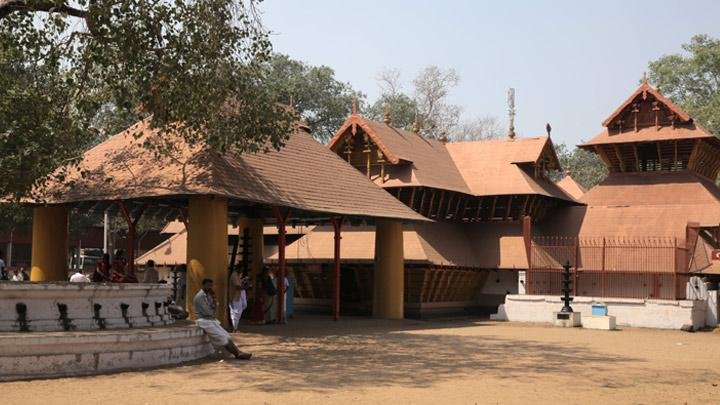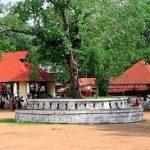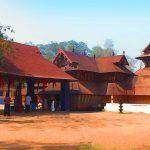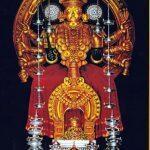Kodungallur Bhagavathy Temple, Thrissur, Kerala
| Date built: | – |
|---|---|
| Deity: | – |
| Architectural style: | – |
| Major festivals | – |
| Locale: | Kodungallur |
| District:: | Thrissur |
| Address: | Pettumma, Kodungallur, Kerala 680664 |
| Phone | 04802803061 |
Sree Kurumba Bhagavati Temple (alternatively Kodungallur Devi Temple) is a Hindu temple at Kodungallur, Thrissur District, Kerala state, India. It is dedicated to the goddess Bhadrakali, a form of Maha Kali or Parashakthi worshipped in Kerala. The goddess is known also by the names “Sri Kurumba” and “Kodungallur Amma” (The Mother of Kodungallur).This temple is the head of 64 Bhadrakali temples in Kerala especially Malabar. The goddess of the temple represents the goddess in her fierce (‘ugra’) form, facing North, featuring eight hands with various attributes. One is holding the head of the demon king Daruka, another a sickle-shaped sword, next an anklet, another a bell, among others. Routine worship at the temple every day at 03:00 and ends at 21:00 local time.
The temple is often accredited as the original form of Goddess Kali.During the reign of Later Cheras, Mahodayapuram (Kodungallur) was the capital of the Chera empire and one of the most important parts of the region. The temple is in the centre of Kerala and is called ‘Malayala Bhagavathi’ by Tamil speakers. The Temple was built in a remote past and its worship incorporates ancient Shaktyem customs which are rarely observed in contemporary Kerala temples.
Kurumbakavu Bhagavathi Temple, popularly known as Kodungallur Bhagavathy Temple is located about 1.5 km southeast of the Kodungallur bus stand. It is assumed that the placement of the idol of Kannaki was done about 1800 years ago by Cheran Chenkuttuvan of the Chera dynasty. The presiding deity of the temple is Bhadrakali (Goddess Kali). The shrine is crowded on Tuesdays, Fridays and Saturdays and is busy during the Sabarimala season as well.
The most famous festival of Kurumbakavu temple is the Bharani festival or Kavutheendal, which starts on the Bharani asterism, as per the Malayalam month of Meenam (March-April). The animal sacrifices that once were part of the festival in this temple are now banned, but the pilgrims still drink liquor and sing lewd songs, all the way from their villages to the shrine, as part of the ceremony. At the end of the festival, the temple closes and opens on the seventh day, after the Aswathi asterism. Another important festival at this temple is the Navarathri.
Architecture
The temple is situated in the middle of a plot of land about ten acres, surrounded by banyan and peepal trees. The srikovil is facing north. The western chamber of the inner temple is the seat of Sapthamatrukas (Seven Mothers) who also face north. The idols of Ganapathi and Veerabhadra are found in the chamber, one facing east and the other facing west, respectively. The idol of bhagawati is about seven feet high and made of wood, carved from a jackfruit tree. The idol has eight arms that carry weapons and symbols.[5]
To the left of the temple sits a small stone structure called ‘the Samadhi of Vysoori’, perhaps a medieval shrine for a deity of smallpox, chicken pox, mumps and other contagious diseases. Devotees make offerings of turmeric powder, sprinkled and rubbed on its walls. About fifty metres further is a sacred pond called (Pushkarini), where devotees bathe before entering the main shrine. It is believed that this pond was created by the goddess by striking the ground with her sword.
Legend / Local stories
It is said that the temple was constructed by Cheraman Perumal. The first Shakteya Pooja in kodungallur temple was performed by a Thiyyar from Malabar. Even present day , The Thiyya thandans (A administrative position) of 64 tharas meet at Nilapaduthara at Kodungaloor in the presence of kodungallur raja. The kodungaloor meena bharani is conducted under these Thiyya thandans.
In Tantric terms, the divinity is installed in what is called the “Rurujit Vidhaana” pattern, a form of installation with Shiva in one end, Ganesha in the other, with the Sapta Matrikagoddesses in between.
According to another belief, Kannaki, the heroine of Ilango Adigal’s Tamil story Silappathikaram attained salvation. She came to Kodungallur, prayed to Bhadrakali of Kodungallur and became absorbed in the murti.
In ancient times, animal sacrifices were offered at the temple, mostly in the forms of birds and goats, by devotees seeking protection and the fulfillment of their prayers. At the intervention of many “social reformers,” the government of Cochin banned animal sacrifice in any form at this place. At present, only red-dyed dhotis are offered to the deity. Many devotees offer rich presents and gold ornaments.
The people of Kodungallur believe that this temple was, in the olden days, a Shiva shrine and it was Parasurama who installed the murti of Bhadrakali close to one of Shiva. The pujas are conducted, it is said, under direct instructions from the goddess herself. Five ‘Sri Chakras’, said to have been installed by Adi Shankaracharya, are believed to be the main source of the powers of this deity. The priests are Namboodiris and Adikas (Madhu Brahmins) who have a right to perform ‘Pushpanjalis’ to the Goddess.
Photo Gallery
How to Reach:
Contact Details
Official Address





